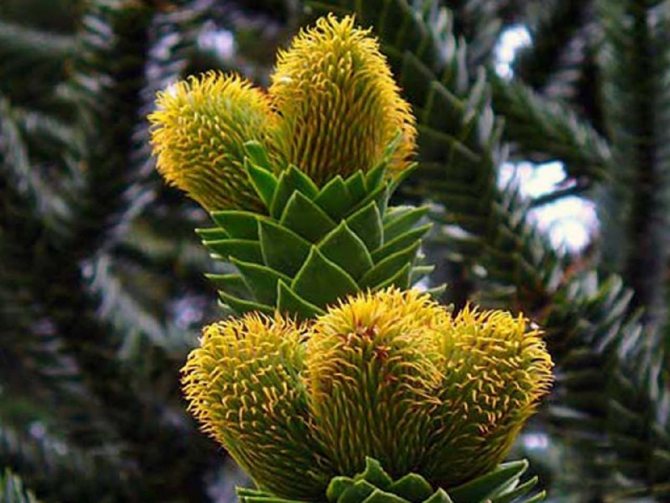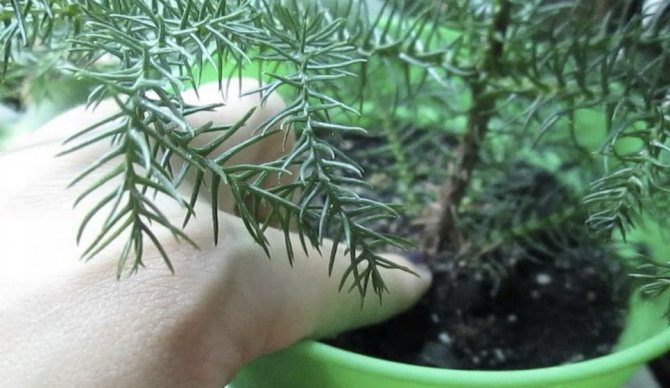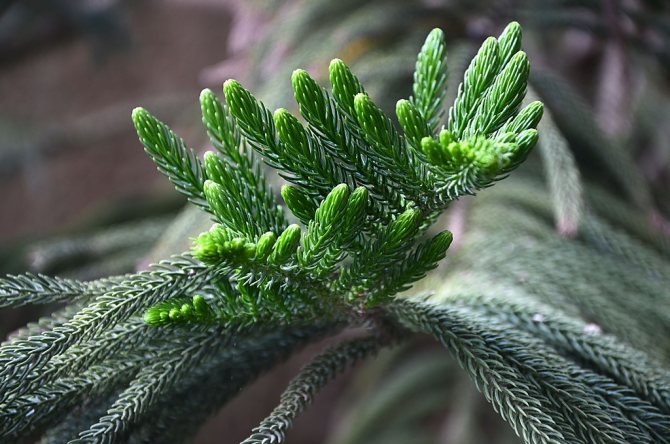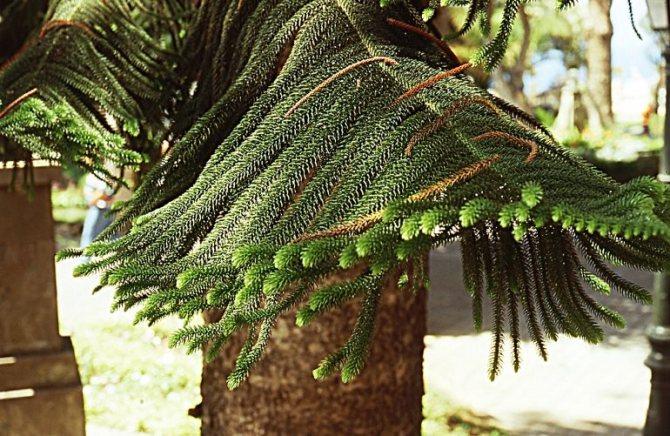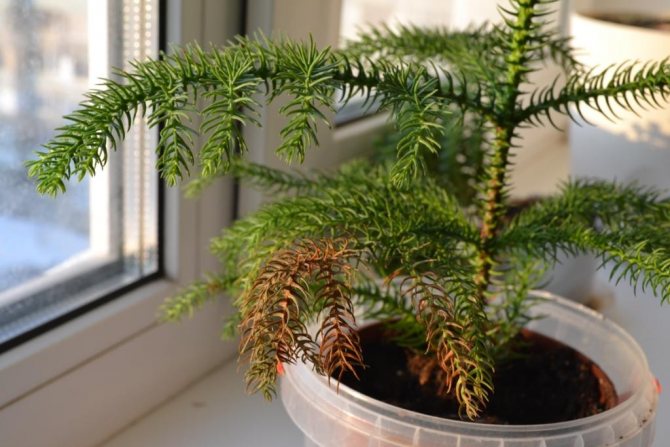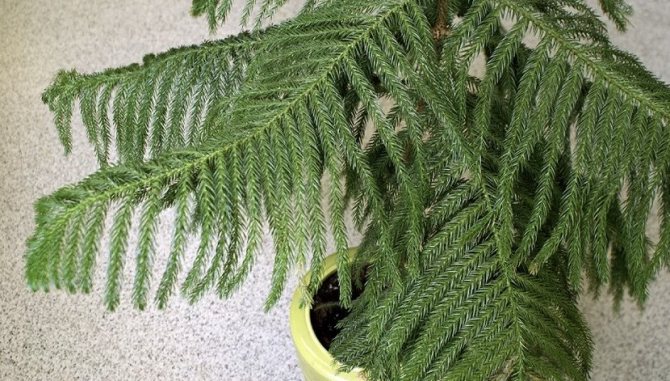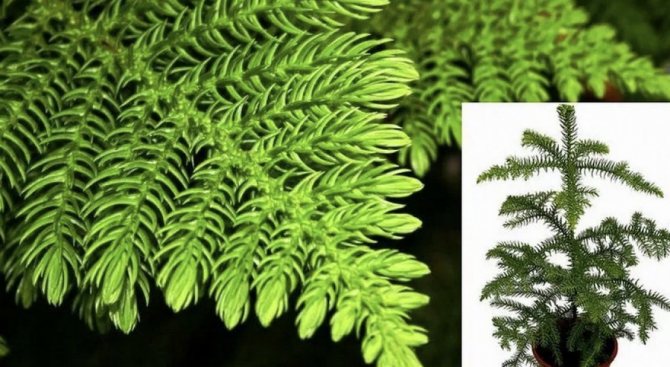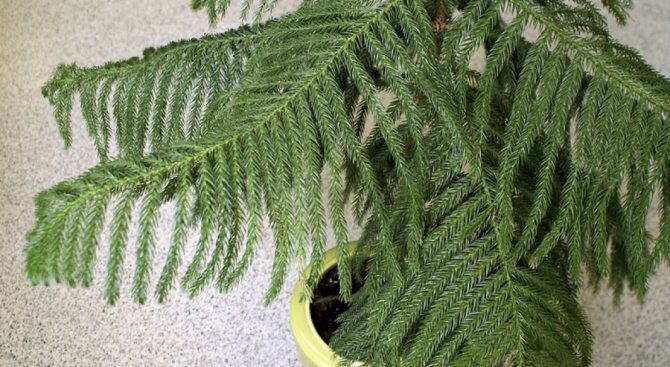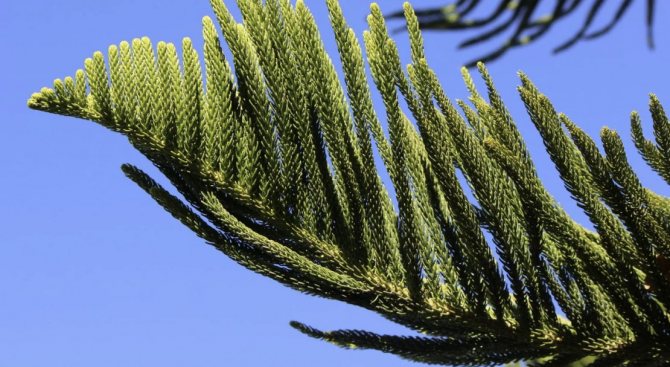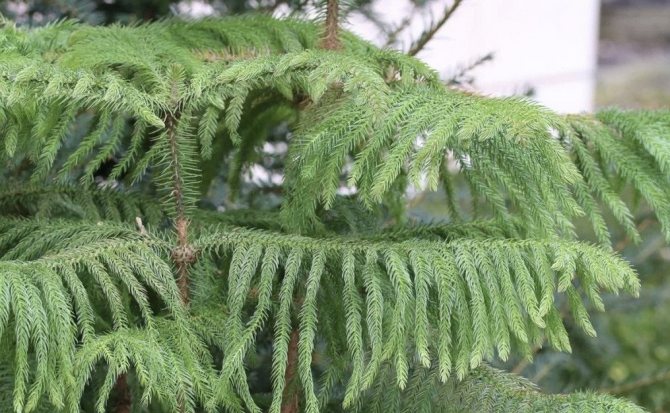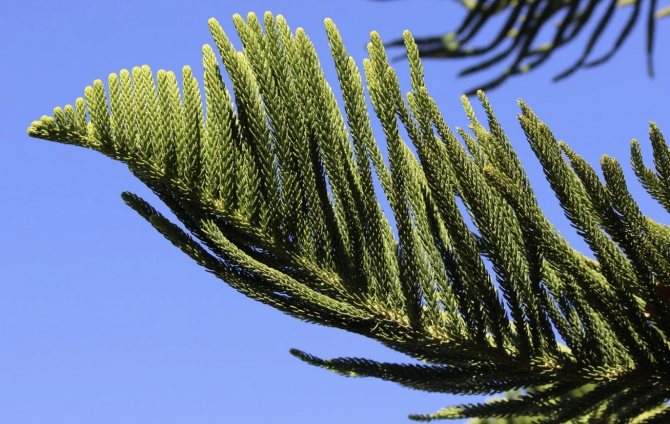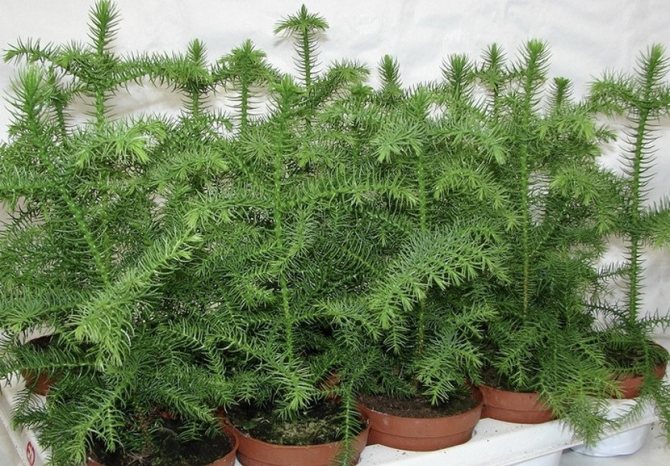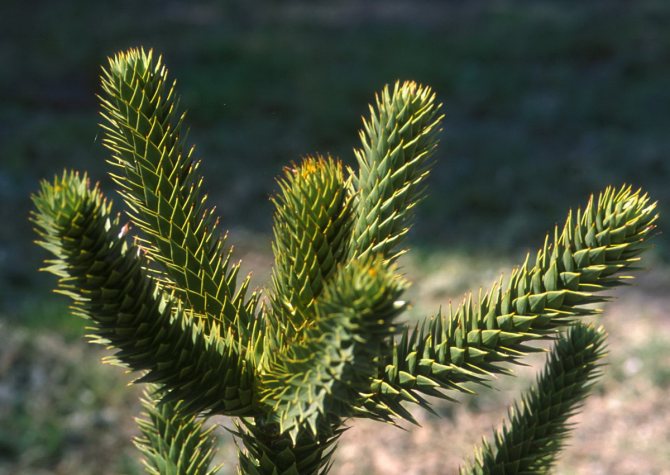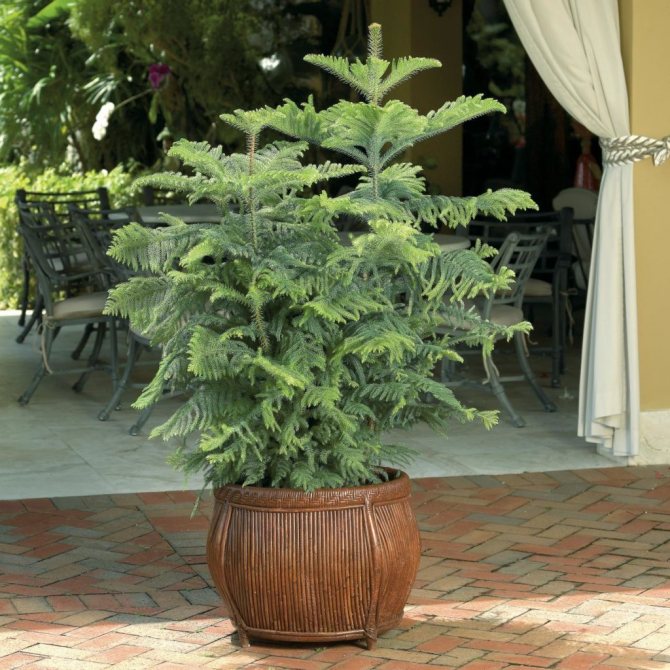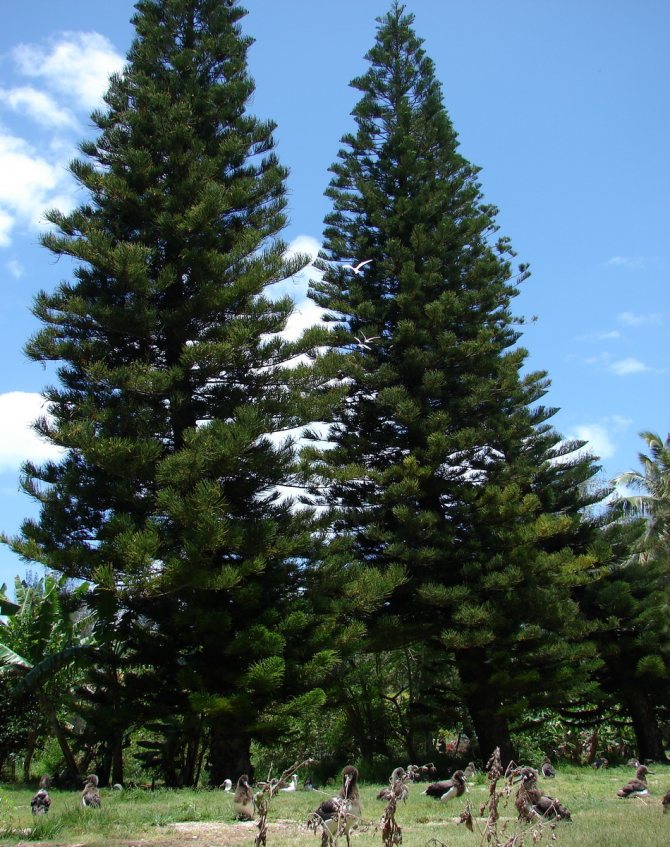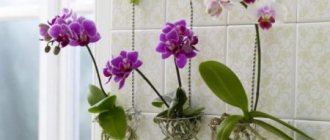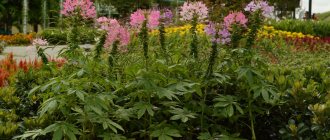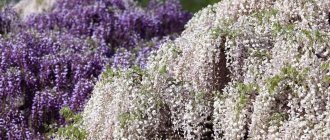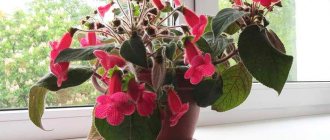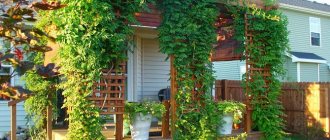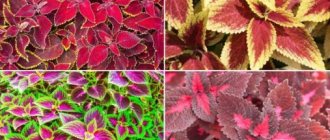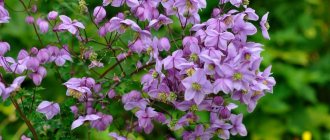Among the rare indoor plants, you can see a beautiful Christmas tree, reminiscent of a joyful New Year's Eve. But the plant was not bought at the Christmas tree bazaar. The relict Araucaria, grown on our own, adorns our home all year round.
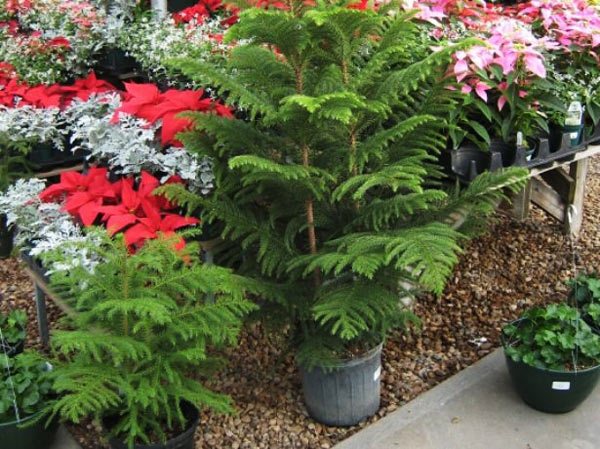
Growing Araucaria in the conditions of ordinary city apartments is not entirely easy... In order for the unusual "Christmas tree on the contrary" to please the owners with its appearance for a long time, fill the room with a special aroma, it is necessary to follow the recommended rules of care.
And then the branches, directed upward, and not downward, like ordinary trees, covered with evergreen needles, will be able to recall the distant Jurassic period of the Mesozoic era, when Araucaria reigned in a warm climate... What is this magic tree of antiquity?
Araucaria - description
The araucariaceae family owns about 14 plant species of the genus Araucaria (lat.Araucaria)... The homeland of the genus is South America and Australia. Representatives of the genus are conifers with hard needle-shaped leaves.
Araucaria seeds can be eaten and wood is widely used in furniture making. In the Caucasus, off the Black Sea coast, some species are grown as ornamental. Growing araucaria in dry room air will lead to difficulties - this plant is more suitable for growing in greenhouses. If you do not adhere to the rules of care, the plant can get sick or even die.
Not many conifers can be grown at home - araucaria is one of them. Araucaria is an ornamental deciduous plant (since it is almost impossible to achieve flowering when grown in a room), which is grown in pots or in compositions in winter gardens. The araucaria plant is said to purify the air, like its other coniferous relatives.
Plant information
The plant belongs to the genus of evergreen conifers from the Araucariaceae family. In nature, these are real giants, long-livers with a flat top.
Found fossilized cones of Araucaria confirm the age of about 220 million years. Often it is called the Chilean pine, the sacred Pehuen tree of the Mapuchi Indian people, who consume cone seeds for food.
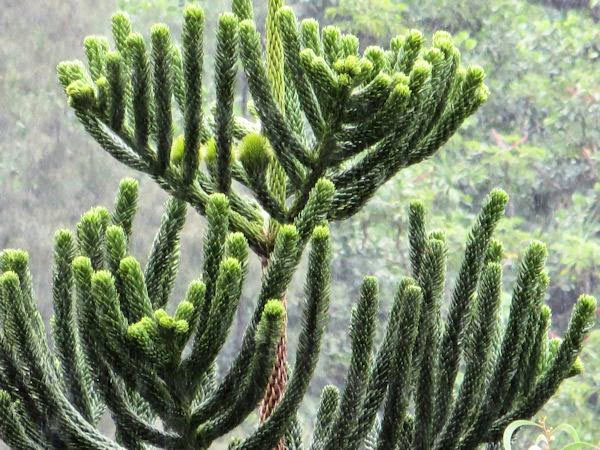

Norfolk people call a tree norfold pine... They successfully sell seeds to support the economy. The coat of arms, the flag of the island in the Pacific Ocean, adorn its branches. In Europe, the tree has become famous since 1843.
It was brought by the English scientist Bidville for the Royal Botanic Gardens. Araucaria bidwillii is considered the first plant species to conquer Europe. Several types of araucaria are now well studied, intended for growing at home.
Planting and caring for araucaria
- Bloom: grown as an ornamental deciduous plant and rarely blooms at home.
- Lighting: bright light, but shaded from direct sunlight.
- Temperature: in summer - not higher than 20 ºC, in winter - not lower than 10 and not higher than 15 ºC.
- Watering: plentiful in summer, in winter - as the earthen coma dries up to 2/3 of the depth.
- Air humidity: increased. Regular spraying is recommended.
- Top dressing: during the period of active growth twice a month with a complex fertilizer with a low calcium content.
- Rest period: from late autumn to spring.
- Transfer: in spring or early summer: young araucaria - as the pot fills with roots, adults - no more than once every 3-4 years.
- Substrate: two parts of sod land and sand and one part of leafy land and peat.
- Reproduction: seeds and cuttings.
- Pests: aphids and mealybugs.
- Diseases: all araucaria diseases from poor care and improper maintenance.
Read more about growing araucaria below.
Housekeeping difficulties
For all its unpretentiousness, the tree has several features that the owner should be aware of in order to take timely measures to correct an unfavorable situation.
| The plant turned yellow. | This is how homemade spruce reacts to improper care and neglect. The whole difficulty lies in some postponement of the bad reaction of the araucaria to the uncomfortableness and lack of proper care, so often help is late, then the araucaria can be lost forever. Other reasons for the yellowness of the crown are admitted drying out, inept transplanting, causing damage to the root system. |
| Pest attack | Most of all, the tree suffers from the attacks of the root beetle, aphids or small mealybugs. Control measures: washing with alcohol / soap solution followed by spraying with special insect control agents. |
Home care for araucaria
Lighting
Despite the fact that indoor araucaria at home prefers bright lighting, it is advisable to hide the plant from direct sunlight. In the summer, it can be taken out into the fresh air in a place protected from rain and sun. The best placement option is for the light to fall on the plant from two sides at once. If the light comes from only one side, the araucaria must be rotated 90 ° C weekly to ensure even growth.
- Soil preparation for seedlings
Temperature
Homemade araucaria needs cool content. The optimum temperature in summer is around 20 ° C. In winter, the temperature should be around 10 ° C, but should not rise above 15 ° C.
Watering araucaria
Water araucaria with settled water throughout the year. In the summer, an earthen coma cannot be brought to dryness (it can be a hassle), so watering should be abundant, but you need to make sure that excess water does not linger in the pot. In winter they water less, especially if the plant is kept at low temperatures.
Spraying araucaria
It is advisable to spray indoor araucaria with water at room temperature (previously, the water must be allowed to stand for at least a day). They are sprayed both in summer and in winter, especially if the plant overwinters in a room with central heating.
Feeding araucaria
In the spring and summer, the araucaria tree is fed twice a month with a very weak solution of fertilizers with a low level of calcium content. It will not be superfluous to fertilize the plant with mullein infusion every four weeks.
Araucaria transplant
If the roots have completely filled the pot, then the plant should be replanted. This is done in early to mid-spring or summer. Homemade araucaria does not tolerate transplanting very well, so it is worth replanting those plants that have grown well. Adult specimens are transplanted every three to four years in a wide pot with a mixture of 2 parts of sand and turf and one part of peat and leaf. Another option is that the substrate is made up in equal parts from humus, sand, peat, deciduous, coniferous and sod land. There must be high-quality drainage at the bottom of the pot, which will not allow excess water to stagnate in the pot. This plant grows very well in hydroponics.
Araucaria from seeds
Araucaria seeds cannot be stored for a long time, therefore they are sown as soon as they are harvested. They are planted in individual pots.Two substrates are suitable: a mixture of equal parts of sand, leaf, turf and peat soil; another option is sand with peat with a small amount of fine charcoal. The soil is watered a little and covered with a thin layer of sphagnum. The pot needs to be ventilated and sprayed from time to time, and the temperature should be around 20 ° C. Seeds germinate in different ways - some after 2 weeks, others after 2 months. When the roots of a young araucaria completely fill the pot, it is transplanted into a larger pot.
- Photo of hibiscus with species names
Propagation of araucaria by cuttings
For propagation of araucaria, the upper branches of the plant, which are half woody, are suitable. They are cut a few centimeters below the whorls in early to mid-spring. The cuttings should lie in a shady place for 24 hours, after which the resinous juice is cleaned from the cut on the cutting and powdered with finely crushed charcoal. It will not be superfluous to process the sections with a root formation stimulator. Cuttings are planted in individual containers with sand or with a mixture of equal parts of sand and peat, after which the container with cuttings is covered with a cut plastic bottle or glass jar. Pots of cuttings are regularly ventilated, sprayed and kept at 25 ° C. At this temperature, the cuttings will take root in a couple of months, but if the temperature is lower, it may take up to five months for rooting - you need to be patient. When the cuttings are rooted and the roots completely fill the pot, the young araucaria is transplanted at home into a large pot with soil for an adult araucaria.
Temperature
Araucaria, a potted home tree, prefers coolness. The most suitable temperature range for araucaria is 12-22 degrees.
The plant tolerates small drops in temperature well, but not lower than 6 ° C. But high temperatures can weaken it: photosynthesis will be disrupted, growth will slow down.
It is recommended to keep the plant cool in winter.... The room temperature should not exceed 15 ° C. Cool wintering is a prerequisite for proper development, good growth and decorativeness of the plant.
In this case, it is necessary to regularly ventilate the room. Araucaria winters well on glazed and unheated loggias, as well as on bright verandas.
Diseases and pests of araucaria
Araucaria does not grow after pruning. If you damage the upper part of the plant, then its further development may be incorrect or stop altogether.
When growing araucaria in an apartment, special attention should be paid to air humidity (should not be dry), lighting (there should be a lot of bright diffused light), temperature (should not be too low in winter).
Araucaria dries and crumbles. The needles fall off, and the shoots dry and turn yellow if the araucaria lacks moisture and light.
Araucaria branches droop from over-watering or too high a temperature.
Araucaria grows slowly. The plant slows down development and growth if there is too much calcium in the substrate.
The branches of the araucaria are thin. Young shoots will be thin if fertilizing araucaria is insufficient.
- Christmas: care, reproduction, illness
Araucaria pests. The plant is damaged by both pests of conifers and the usual mealybugs and aphids.
Needles and cones
Araucaria are conifers and have much in common with the spruce, fir or even pine that are familiar to us. Close branches in the form of false whorls make it easy to determine the age of trees and create similarities with the conifers we are used to, but the shapes of the needles differ.
If the general appearance of the representatives of the genus is quite close, then the structure of the leaf apparatus in individual species of araucaria is outwardly different. Spiral needles in some species are more like leaves with a drawn sharp tip, while in others they look like needles.


The needles stay on the trunks for a long time, and for the species of the genus Araucaria, branch fall is characteristic, which over time leads to the cleansing of the trunk and the formation of an umbrella-shaped crown. In general, the process is typical for light-loving breeds. In this they are similar to pines and grow in ecologically similar areas.
Araucaria cones are spherical or elongated-ovate, large, up to 35 cm long, woody. The seed and covering scales are accrete, the seeds are immersed in the tissue of the scales and, after ripening, fall off with them.
Cunningham araucaria female cone contains naked seeds
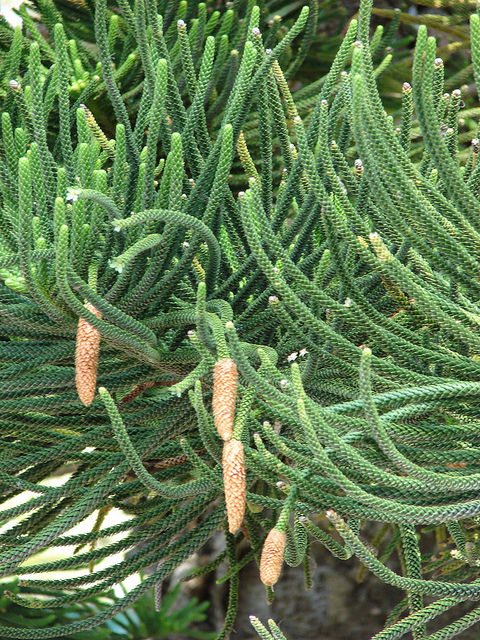

Cones of araucaria columnar
Araucaria species
Araucaria Cook / Araucaria columnaris
Habitat - about. Pine and tropical part of the southern New Hebrides. Branches from the trunk grow at an almost 90 ° C angle, gather in whorls, relatively short. Usually the crown expands towards the apex. The cones grow up to 10 cm in length and appear bristly due to the subulate appendage drawn downwards. The leaves are soft, the tip tapers very smoothly. Usually this species is grown by residents of tropical and subtropical countries.
Araucaria heterophylla (Indoor Spruce) / Araucaria heterophylla
Or Indoor Spruce. They live on Norfolk Island and grow up to 60 m.The bark is brownish in color, peels off. The branches grow perpendicular to the trunk, which gives the crown of the plant a pyramidal shape. The leaves on the branches grow in a spiral, needle-like, grow no more than 2 cm in length, tetrahedral and slightly bent upward. Amateur flower growers often mistake this species for Araucaria excelsa - tall araucaria.
Araucaria angustifolia / Araucaria angustifolia
It lives in the mountainous part of southern Brazil, where it is also known as Brazilian araucaria (Araucaria brasiliana). Under natural conditions, these trees grow up to 50 m, and in rooms - up to 3 m. On thin hanging branches, bright green five-centimeter leaves of a linear-lanceolate shape grow. Wood of this type is used in the construction and furniture industry, in the production of paper and musical instruments.
Of an ancient kind
In the nature of the Northern Hemisphere araucaria (Araucaria) of of the eponymous family Araucariaceae (Araucariaceae) little known, primarily because they are thermophilic and tend to the subtropical climate.
Interesting
The genus received its scientific name due to the coincidence of the range of some species of the genus with the places of residence of the group of Araucanian tribes.
Paleobotanical data indicate that representatives of this ancient family, once widespread in our latitudes, could not survive the glaciation and remained only in the opposite hemisphere. The antiquity of the genus Araucaria is confirmed by the discovery of its traces in the Permian deposits and by the ruptured area. Its representatives live in South America, Australia and the island territories.
Like many ancient species, araucaria are long-lived. Some plants are estimated to be 2,000 years old.
The soil
In what conditions does araucaria prefer to grow? For araucaria, a soil that has a slightly acidic reaction is important.
You can buy such a substrate, or you can cook it yourself.
It is prepared on the basis of soil collected in a coniferous forest (up to 30%), coniferous litter (about 10%), sand (no more than 10%), peat and sod land, taken in equal quantities.
Soil for araucaria may have a different composition. It may include in equal parts:
- Leafy land;
- Sod land;
- Coniferous land;
- Peat;
- Sand.
Such soil will differ in water permeability. In flower shops you can buy ready-made potting soil for araucaria. Purchased soil for rhododendrons is also suitable., which, like the soil for conifers, has a slightly acidic reaction and contains a peat component.
Trim / Support / Garter
Pruning araucaria, like most gymnosperms, should only be done when absolutely necessary.
Removing a large branch dramatically reduces the decorative effect of the plant, and the regrowth of new shoots is slow.
Therefore, when forming the crown, they adhere to the following rule: the shoots are shortened at a young age, while the needles have not yet appeared.
With age, the lower branches of araucaria sometimes droop unnecessarily. You can return them to a horizontal position with a timely garter. It is advisable to tie the branches while they are still soft enough, then it is easier for them to give the desired shape. Some growers prefer to adjust the direction of the branches with a suitable support.
Reproduction
Propagated by seeds and stem semi-lignified cuttings.
Seeds are sown immediately after harvest, as they quickly lose their germination. They are sown one at a time in pots filled with a mixture of peat soil and sand, with the addition of a small amount of charcoal, or from leaf, peat, turf and sand. Moisten, cover with a layer of sphagnum on top, and put the pots in a room with a temperature of 18-20 ° C. Spray and ventilate periodically. Seedlings appear unevenly, from 2 weeks to 2 months. Seedlings dive after the appearance of the first bunch of needles, but if the seedlings are planted one by one in a pot, then they are not dived, but left until the roots of the plant cover the entire lump, after which they are transplanted into large containers.
When propagated by semi-lignified cuttings, they are rooted in March-April. The semi-lignified tops of an adult plant are cut into cuttings, 3-4 cm below the whorl. Before planting, the cuttings are dried in a shady place for 24 hours. Then the sections are cleaned from resinous sap and powdered with charcoal powder. Also, before planting, cuttings can be treated with a root stimulator (heteroauxin). Cuttings are planted for rooting one at a time, in a moist substrate consisting of peat and sand (1: 1), or simply in sand. Cover the top with a transparent cap (jar, plastic bottle). Rooting is faster in a mini greenhouse with bottom heating. Maintain the temperature within 24-26 ° С, constantly spray and ventilate regularly. Rooting of araucaria cuttings is a long process, it occurs after 2 months. If the temperature at which the cuttings are kept is low, then rooting can take up to four to five months. After the coma is entwined with roots, the rooted blacks are planted in a substrate suitable for an adult plant.
Watering
Araucaria should be watered evenly throughout the year. Araucaria does not tolerate overdrying of the soil substrate.
But stagnation of water in the pot must also be avoided. For this, a good drainage must be arranged in the flowerpot. For watering, use soft (or boiled) settled water.
The plant does not like waterlogging of the soil in the pot. When the water stagnates, its needles begin to turn yellow and fall off. Even more dangerous for him is the complete drying out of the earthen coma. This can lead to the death of the plant. Therefore, it is necessary to regularly monitor the moisture content of the soil in which the tree grows. Watering should be done only when its top layer dries out to a depth of at least 2 cm.
Photo gallery
The branches, represented by annular whorls, are located almost perpendicular to the trunk; they form a pyramidal crown. Shoots are covered with flat, needle-like formations of bright green color, replacing leaves. Araucariae are dioecious and monoecious. During flowering, male specimens form drooping inflorescences - strobila, female specimens form elongated male inflorescences and female ones - ball-shaped. Araucaria enter the fruiting phase at 40-50 years of age. After pollination, spherical decaying cones form on the female plants. At home, flowering is impossible.
| Root system | Rod |
| Trunk | Erect |
| Leaf shape | Needle-shaped |
| Leaf color | Light green |
| Flower shape | Elongated, spherical |
| Flower color | Several tones lighter than the needles |
| Fruit shape | Spherical |
| Fruit color | Brown gray |
Benefit
Araucaria has phytoncidal properties. Various vitamin drinks are often prepared from this needles to maintain immunity and improve well-being. Such a drink will be useful in winter, but in summer it will not be superfluous.
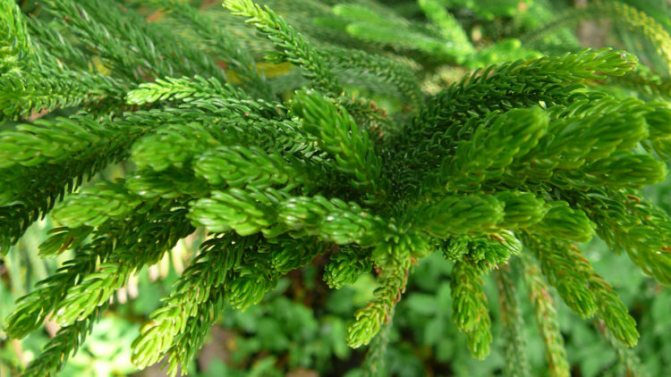

Araucaria is brewed and made into a decoction. It is used for tuberculosis, cough, dropsy, colds and skin diseases. Also, often such tinctures and decoctions are added to a hot bath to eliminate sciatica and rheumatic pains.
Fertilizer
The development of araucaria is slow, therefore, the need for fertilizers in the "home spruce" is low. Usually it is fed in spring and summer.
At the same time, the degree of dilution of fertilizer mixtures is done much more than for most other plants: the concentration of a solution of mineral substances is half the usual rate.
High calcium content in fertilizer should be avoided... Organic fertilizers are completely unacceptable for araucaria.
Why Araucaria Don't Need Rain, Direct Sun And Peace
Araucaria living in an apartment is a young plant when compared with long-lived trees. And the secret to preserving her health is simple - home conditions should be close to those of a tropical forest. Only not its upper tier, but much lower. If you managed to recreate the humid climate of the tropics, provide diffused light, then you are on the right track.
Groom, water, feed, spray
Street rain will not do any good for your home tree. We are talking about man-made precipitation - watering. It needs soft, demineralized water. We'll have to boil it, defend it or filter it. By the way, the same requirements for spraying water.
All year round, except for winter, araucaria requires a lot of water. But it is necessary to maintain a balance between dryness and waterlogging of the soil. Watering should be done when the soil is dry on top. An earthen lump in a pot should not be turned into a biscuit, but a swamp is also bad. When in doubt as to whether or not to water, try touching the ground 3–4 cm deep. Dried up - water, slightly damp - better spray. Araucaria will also receive a dose of moisture through the thorny crown.
In winter, it is recommended to reduce watering, especially when kept cool. But in a warm room, the moisture of the araucaria should be enough. Observe the state of the tree and react to changes in its appearance. Remember to keep the humidity high. Dry air is the main enemy of araucaria. By the way, it is advised to add "Epin" or succinic acid to the water for spraying.
Araucaria will be glad to have additional food. This is understandable if you remember that the plant is transplanted quite rarely. It is necessary to feed a home Christmas tree from spring to late summer, on average, once every two to three weeks. Mineral fertilizers for conifers from the store will do. But pay attention to the calcium content in them, it should be a minimum amount. Excess nitrogen causes the trunk to stretch too far between the tiers of branches. Make a solution for feeding twice as weak as in the instructions for the preparation.
Evergreen araucaria does not need rest
The Christmas tree is indifferent to the dormant period, which many plants cannot do without, it is evergreen. Without a doubt, araucaria slows down growth in winter. But this cannot be called a full-fledged rest. Rather, it is due to seasonal changes in the climate of our apartments. As flower growers assure, araucaria winters well on a warmed loggia, if the temperature on it is not lower than plus 10 degrees. It is good if the room is not very bright in winter, but cool. Or if the temperature is moderate - 20 degrees, but there is a lot of light. But araucaria will not tolerate a hotly heated, poorly ventilated and dark room.
Correct lighting
It is known that, in nature, the branches of the trees on the north side are less long and dense. To grow a harmonious araucaria tree, it is required to organize uniform double-sided lighting. If this is not possible, the pot with the plant is turned 90 ° weekly. In winter, daylight hours are artificially extended.


At home, araucaria grows on forest edges, far from other trees. In the house, it also requires a separate space. Araucaria does not tolerate direct sunlight. A coniferous plant can thrive in partial shade with sufficient daylight hours. In the summer, a pot with a Christmas tree is taken out to a closed loggia or to a garden under the shade of trees.
Errors of agricultural technology of araucaria varifolia
Araucaria is characterized by a delayed reaction to the changes that have occurred.
The yellowing of the branches and the dropping of the needles are observed when the substrate dries out or waterlogged. Plants react in the same way to too dry air.
The room tree informs about the lack of moisture by the lowered branches and will no longer return them to their previous position on their own. Installation of temporary supports is permissible. The lower branches of the araucaria shed the needles from the lower branches as they mature. Careful pruning of bare branches is recommended.
New branches grow too thin, the plant slows down or does not grow at all, if the substrate is depleted and urgent reloading is necessary. Also, the growth of araucaria slows down with an excess of calcium. Of the numerous pantheon of pests, aphids, mealybugs, and root beetles are a real threat. The plant will be saved by treatment with insecticides, a solution with the addition of soap and alcohol.
Araucaria's branches are dropping, what should I do?
This is a fairly common problem, and its causes are similar to yellowing of needles. The plant is hot and / or not properly watered. In the initial stage (the branches have dropped a little and recently), it is enough to adjust the conditions of detention and temporarily tie up the branches, slightly lifting them up (be careful, you can break them!). If the problem is running, you can do the following. It is good to moisten the soil, allow excess water to drain, put the pot in a bag and tie it so that the earthen ball is fixed. After that, turn the plant over and hang it for several days in this position, with the roots up.
Features of the
Consider how to care for araucaria at home, depending on the characteristics of the plant.
In order for the araucaria to grow equally lush on all sides, it needs to be provided with uniform illumination.
To do this, the araucaria standing on the windowsill is turned a little every day. It is also possible to provide proportional development with additional illumination.
Araucaria is a plant for spacious rooms with good air circulation... In small rooms, with a lack of fresh air, it grows poorly, and its needles turn yellow. Also, it should not be kept in rooms with central heating in winter. High temperatures and low humidity will quickly affect the health of the plant and its appearance.
In summer in temperate climates, the plant always suffers from heat. It is necessary to provide him with a cool corner in the house or in the fresh air and regularly spray the needles with rainwater.
Mr. Summer resident informs: araucaria - benefit or harm
The plant has powerful energy. It can awaken creativity, provoke people to be active. Moreover, the action is both positive and negative. Araucaria enhances the energy in the house, no matter what it is. There is a sign that the plant in the house activates the protective properties, gives peace and tranquility to those living in it.
The beneficial property of spruce is that it moisturizes and purifies the air. People with hypertension should not keep it in the house. And for those who have low blood pressure, on the contrary, it is necessary, but you cannot put it in a relaxation room.
To crop or not to crop?
Novice owners of araucaria often ask the question: should it be cut off? Arguments in favor of pruning: the crown will become more luxuriant, the tree will be updated and look better. Experienced needle breeders answer unequivocally: if you dream of growing a semblance of a slender New Year's tree, pruning araucaria is not needed, it can only do harm. Conifers inevitably lose their lower branches with age, and no pruning will bring them back. But you can break the harmonious growth by cutting the Christmas tree.
Forming spruce bonsai
However, on the issue of pruning, one cannot be absolutely categorical. Sometimes you can't do without it. This procedure is necessary if you are forming bonsai from araucaria. But then the care of the plant should be special.
If you decide to grow a bonsai tree from araucaria, then replant your tree more often: once a year or two. Each time, the roots must be shortened by half. Such araucaria needs a special low ceramic container and soil with a high sand content, so that the tree grows very slowly, but constantly.
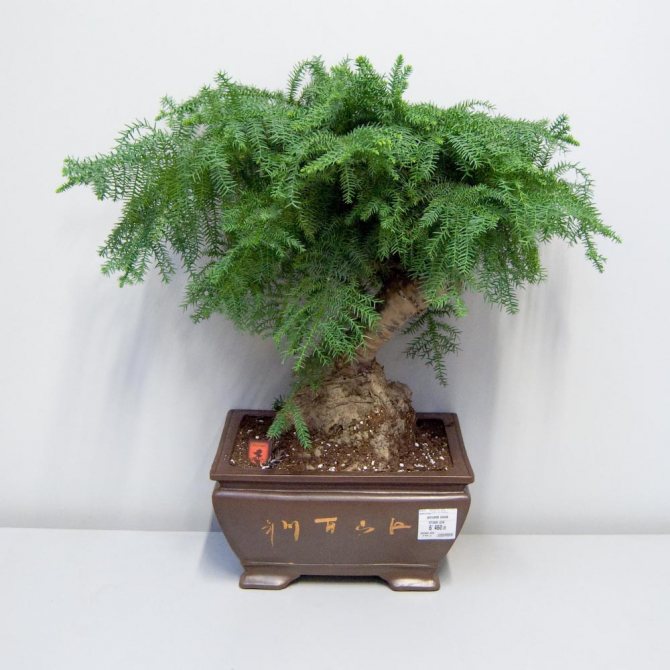

It is quite possible to form a bonsai from araucaria
The plant is kept at a temperature of at least plus 17 degrees, even in winter. There should be a lot of light, but no direct sun.
Araucaria bonsai must be pinched and trimmed. In spring, young shoots are pinched and the crown is corrected. Branches that worsen the appearance or turn yellow are cut off. A special wire is used for the formation. It cannot be used on young shoots and should not be left on for longer than 4 months.
The tree should be watered regularly and sprayed daily. In spring and autumn, araucaria bonsai is recommended to be fed with slowly decaying organic fertilizer.
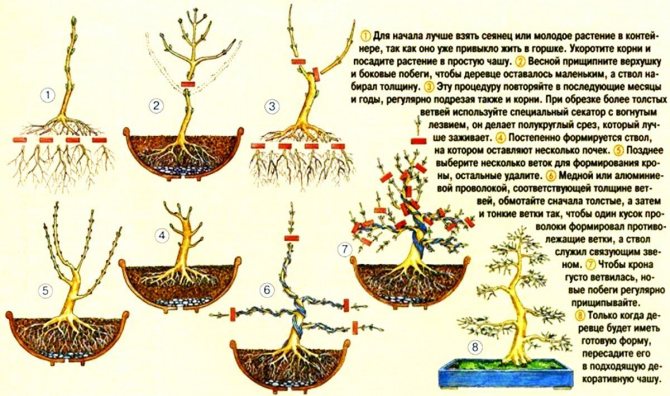

Stages of growing bonsai-style trees
Basic transplant rules
Araucaria needs a transplant every 3-5 years in the spring, but not more often, since changing the place of growth is painful for it. In addition, she has very vulnerable roots, damage to which can easily lead to her complete death. Transfer is carried out by transshipment. The clod is removed completely and placed in a larger drainage pot, which should be 1/4 of the height. It is important to keep the root neck at the same level, without deepening or exposing it. The size of the pot regulates the growth rate. If the growth of room spruce is undesirable, the same container is left.
Important! Araucaria is a participant in symbiosis with soil fungi, which is beneficial to both. Therefore, it is not recommended to clean the root system of old soil.






